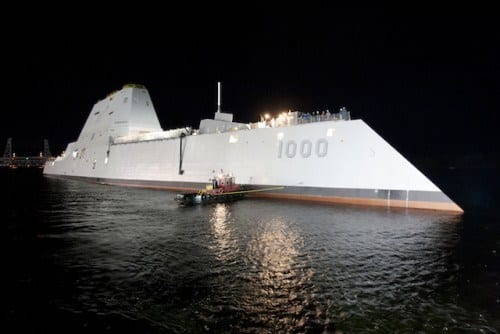We were just taking note of the US Navy’s focus on stationary, portable, and even wearable microgrids when along comes a doozy of an example in the form of the USS Zumwalt DDG 1000. The newly launched high-tech destroyer has been dubbed the Navy’s first “all-electric” ship, but not because you can plug it into a wall socket. The Zumwalt’s distinctive feature is a fully integrated power system that both generates and distributes electrical energy everywhere in the ship, including the propulsion system as well as weaponry and support services.
A Floating Microgrid For The US Navy
The actual power source of the Zumwalt is a 78 megawatt array of four gas-turbine generators, but that’s the extent of the role of internal combustion engines on the ship. Here’s a rundown provided by our friends at the technology association IEEE:
…the Zumwalt’s propellers and drive shafts are turned by electric motors, rather than being directly attached to combustion engines. Such electric-drive systems, while a rarity for the U.S. Navy, have long been standard on big ships. What’s new and different about the one on the Zumwalt is that it’s flexible enough to propel the ship, fire railguns or directed-energy weapons (should these eventually be deployed), or both at the same time.
Launch of the USS Zumwalt courtesy of US Navy.
Speaking of railguns, another energy-intensive weapon system that could come into play is the Navy’s new laser weapons system (LaWS). Earlier this year we took note of an article about LaWS from the Office of Naval Research, which makes the case that ships with integrated all-electric power systems are essential to future force effectiveness, given the transition to energy-based forms of weaponry.
Here’s the money quote:
As the technology advances, and faced with rising and unpredictable fossil fuel costs, the Navy’s next-generation surface combatant ship will leverage electric ship technologies in its design. While electric ships already exist, design characteristics of a combatant ship are more complex with regard to weight, speed, maneuverability—and now, directed energy weapons.
For the record, the Zumwalt isn’t quite ready for prime time yet. The launch took place on October 28 at almost 90 percent completion, so there’s more work to be done before it’s fully operational. The Navy expects to have initial shakedowns completed by 2016.
The Zumwalt And You
If you were thinking that “all-electric” ship meant a battery-powered vessel that could potentially be charged from diverse renewable sources, the whole gas-turbine thing is a bit of a letdown.
Since the Zumwalt has just one original fuel source, from that perspective it’s not as advanced in future fuels as the Navy’s new SPIDERS microgrid for land based facilities, which can integrate both renewable energy and fossil fuels. The same goes for the wearable MAPS microgrid, which incorporates a battery that can be recharged from multiple sources.
However, given the Navy’s hand-over-fist pursuit of biofuels, the Zumwalt does open the door to the use of renewable biogas, so that’s something.
More to the point, the development of the Zumwalt and its two planned sister ships involves future electrical systems and energy efficiency improvements that could find application in the next generation of civilian electric vehicles, in addition to the potential for integrating advanced, multi-sourced energy storage systems in military vessels and vehicles.
Read more at http://cleantechnica.com/2013/11/05/us-navy-launches-new-all-electric-zumwalt-destroyer/#UzbjqhS3uM8H4Sxq.99









